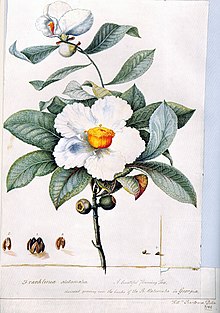Frank line
| Frank line | ||||||||||||
|---|---|---|---|---|---|---|---|---|---|---|---|---|

Franklinia alatamaha flowering at the Tyler Arboretum in Pennsylvania |
||||||||||||
| Systematics | ||||||||||||
|
||||||||||||
| Scientific name of the genus | ||||||||||||
| Franklinia | ||||||||||||
| W.Bartram ex Marshall | ||||||||||||
| Scientific name of the species | ||||||||||||
| Franklinia alatamaha | ||||||||||||
| W.Bartram ex Marshall |
The Frank line ( Franklinia alatamaha ), also called Franklinbaum , is the only species of the monotypic genus Franklinia within the tea shrub family (Theaceae). The synonyms are: Franklinia alatama Raf. , Gordonia franklinii L'Hér. , Gordonia pubescens L'Hér. The species was named after the Altamaha River in the southern United States. It is now extinct in the wild.
description
The Frank line is a deciduous shrub or small tree that branches out in the lower area. This species can reach heights of growth of 10 m. The bark is smooth. The simple, dark green, glossy leaves are about 20 cm long. In autumn the foliage is colored in different shades of red, purple or orange. It is famous for its creamy white, bowl-shaped flowers that reach a diameter of 7 to 12 cm. The petals are waxy. The stamens are golden yellow. The flowering period, which peaks in late September, lasts from July to autumn. The sweet smelling scent has a hint of orange flowers.
history
The "Franklin Tree", as it has been known since 1785 in honor of the American politician Benjamin Franklin , was discovered in October 1765 by John Bartram and his son William at the mouth of the Altamaha River in McIntosh County , Georgia , USA . In 1803 the last specimen of this tree was seen in the wild by the British art gardener and plant hunter John Lyon . The cause of the extinction is considered to be a fungal disease that was introduced by infected cotton . Thanks to the efforts of the Bartrams, this tree is now back in some gardens in the United States, New Zealand, Canada, and Europe. They were the first to collect seedlings and saplings, thus saving this tree from ultimate extinction.
Today gardeners from all over the world can register their own tree online at Bartram's Garden in Pennsylvania , the former Bartrams estate. In 1998, a worldwide census of existing specimens was carried out under the name Franklinia Census : The count resulted in approx. 2000 specimens in gardens, botanical gardens or parks worldwide, all of which are descendants of the trees that the Bartrams once planted in their garden.
In German "art gardeners" (a term that has been out of date since the 19th century) this species is called "Franklinie". According to the statistics of the Franklinia Census, there are 9 specimens in Germany, including one in the Bochum Botanical Garden .
When it was first described, Franklinia was classified in the genus Gordonia . In 1785, there was a dispute over the classification in France. While the new name Franklinia alatamaha was used in the USA , the old names Gordonia pubescens or Gordonia alatamaha remained in Europe until the 20th century .
literature
- Marinelli, Janet: Plants of the World. Fascinating plant diversity on the five continents , publisher: Dorling Kindersley Ltd (DK), London, 2006, ISBN 3-8310-0922-8
- Warda, Hans-Dieter: The big book of garden and landscape trees , Bruns Pflanzen Export GmbH, self-published, Bad Zwischenahn, 2nd expanded edition, 2001, ISBN 3-9803833-3-4
- Koopowitz, Harold; Hilary Kaye: The Death of Plants , Ullstein Verlag , 1989, ISBN 3-548-34553-0
Web links
- Bartram's Garden - Franklinia (English)
- America's first rare plant - The Franklin Tree (English)
- Info at Grin (English)
Individual evidence
- ↑ Franklinia alatamaha in the endangered Red List species the IUCN 2015 Posted by: Rivers, MC, 2015. Accessed April 24, 2020th
- ^ Marinelli, Janet: Plant , p. 108
- ^ The List Franklinia
- ↑ Bartram's Garden - Information on the Franklinia Census
- ↑ Bartram's Garden - Results of the Franklinia Census
